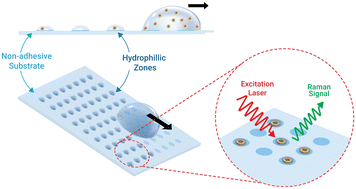Non-adhesive contrast substrate for single-cell trapping and Raman spectroscopic analysis†
Abstract
Droplet splitting by exploiting tailored surface wettability is emerging as an important pathway to creating ultralow volumes of samples that can have applications in bioassays, tissue engineering, protein chips, and material synthesis. Reduction of droplet volumes enables the encapsulation of single biological cells which allows high throughput screening. In this work, we demonstrate a facile fabrication approach to create a non-adhesive contrast quartz substrate that allows droplet splitting under gravitational force and its utilization to trap single biological cells for Raman spectroscopic studies. The non-adhesive contrast surface is created by low-power continuous-wave laser-assisted removal of the region of interest from a biocompatible non-adhesive silicone oil grafted quartz substrate. For a given laser spot dimension, the hydrophilic zone dimension is controlled via irradiation with varying laser powers. The fabricated non-adhesive contrast surface can split a microliter droplet into pico- and sub-picolitre daughter droplets. By using the substrate, the trapping of a single polystyrene bead is demonstrated and the recording of Raman spectra is carried out. Additionally, the Raman spectra of two biological cells, yeast cells and human mononuclear cells (MNCs), from a daughter droplet are recorded independently and from a mixture of the solutions. This single-cell Raman analysis could find applications in cell identification and type discrimination, biochemical imaging, metabolic and functional characterization, and clinical and toxicity studies.

- This article is part of the themed collection: Lab on a Chip HOT Articles 2022


 Please wait while we load your content...
Please wait while we load your content...